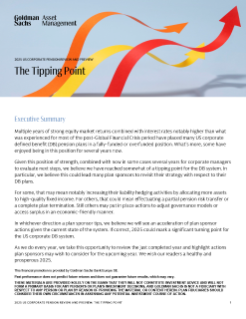2025 US Corporate Pension Review and Preview
The Tipping Point
Multiple years of strong equity market returns combined with interest rates notably higher than what was experienced for most of the post-Global Financial Crisis period have placed many US corporate defined benefit (DB) pension plans in a fully-funded or overfunded position. What’s more, some have enjoyed being in this position for several years now.
Given this position of strength, combined with now in some cases several years for corporate managers to evaluate next steps, we believe we have reached somewhat of a tipping point for the DB system. In particular, we believe this could lead many plan sponsors to revisit their strategy with respect to their DB plans.
For some, that may mean notably increasing their liability hedging activities by allocating more assets to high-quality fixed income. For others, that could mean effectuating a partial pension risk transfer or a complete plan termination. Still others may put in place actions to adjust governance models or access surplus in an economic-friendly manner.
In whichever direction a plan sponsor tips, we believe we will see an acceleration of plan sponsor actions given the current state of the system. If correct, 2025 could mark a significant turning point for the US corporate DB system.
As we do every year, we take this opportunity to review the just completed year and highlight actions plan sponsors may wish to consider for the upcoming year. We wish our readers a healthy and prosperous 2025.
Glancing Back: Another Good Year for Corporate DB Plans
Funded Status Continues to March Higher
Another year of robust US equity market returns, combined with higher liability discount rates, thereby lowering the present value of pension liabilities, has likely pushed funded levels higher once again. As seen in Exhibit 1, our work would suggest the aggregate funded status of the US corporate DB system rose to about 106% as of December 2024 from 101% as of the end of 2023.
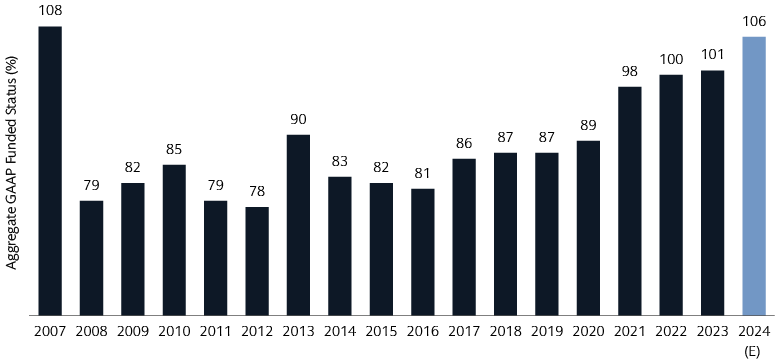
Source: Goldman Sachs Asset Management and company reports. As of December 2024. Based upon all the US (when specified) defined benefit plans of S&P 500 companies. For illustrative purposes only. The 2024 (E) figure is estimated and unaudited as of December 31, 2024 and is subject to potentially significant revisions over time. The economic and market forecasts presented herein are for informational purposes as of the date of this presentation. There can be no assurance that the forecasts will be achieved. Please see additional disclosures at the end of this presentation.
Individual plan results will vary. A plan’s unique asset allocation and hedging strategy will have a notable influence on how its funded status may have changed during 2024. Plans that hedged more of their interest rate risk through higher allocations to fixed income as well as the utilization of interest rate swaps and futures, and therefore had lower allocations to equities and other growth assets, would likely have seen more muted changes to funded levels. Conversely, a plan that had a lower interest rate hedge ratio and a relatively higher allocation to growth assets may have seen more robust gains in funded levels.
Many plans are at different stages of their life cycle and therefore have different goals and objectives. An overfunded and frozen plan may very well have a primary objective of preserving funded status and minimizing the volatility of that metric. Consequently, a muted change in funded status may be deemed a successful outcome given its goals and objectives.
We Expect More Assets Moved into the Liability Hedging Bucket in 2024
Consistent with glidepath strategies that call for allocations to fixed income to increase as funded status rises, we have observed that more plans have moved in that direction in 2024. Of course, with equity outperforming fixed income in 2024, portfolio drift may have tempered some of the changes in actual asset allocations at the end of 2024 (see Exhibit 2).
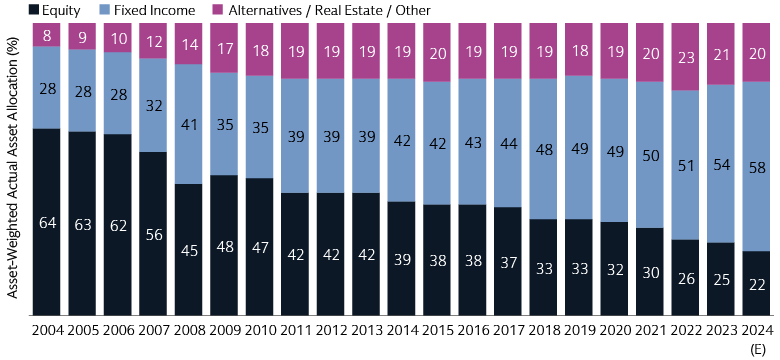
Source: Goldman Sachs Asset Management and company reports. As of FY 2024. Based upon all the US (when specified) defined benefit plans of S&P 500 companies. For illustrative purposes only. The 2024 (E) figure is estimated and unaudited as of December 31, 2024 and is subject to potentially significant revisions over time.
For this reason, among others, we also closely monitor target asset allocation disclosures when we perform our annual pension review based on disclosures in corporate annual reports. These provide a good window into the strategic direction plan sponsors are moving.
Nonetheless, with many plans fully funded or overfunded and, by our estimate, two thirds either closed or frozen, pension plan management has turned for many into a hedging / risk management exercise as opposed to a total return investing strategy. Consequently, allocation to liability hedging fixed income likely rose once again in 2024, as depicted in Exhibit 2.
Highest Discount Rates Since the Global Financial Crisis Could Provide Good Entry Point for De-Risking
Based on market yields at the end of the year, we expect plan sponsors with December fiscal year-ends will use US GAAP accounting discount rates of around 5.7% as of the end of 2024. As seen in Exhibit 3 below, if correct, that would mark the highest discount rates used since the tail end of the global financial crisis in 2009.1
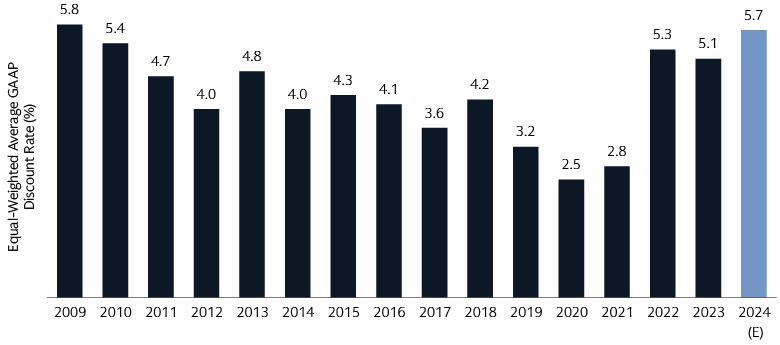
Source: Goldman Sachs Asset Management and company reports. As of FY 2024. Based upon all the US (when specified) defined benefit plans of S&P 500 companies. For illustrative purposes only. The 2024 (E) figure is estimated and unaudited as of December 2024 and is subject to potentially significant revisions over time. The economic and market forecasts presented herein are for informational purposes as of the date of this presentation. There can be no assurance that the forecasts will be achieved. Please see additional disclosures at the end of this presentation. Based upon the arithmetic average of US plan discount rates (when specified) of S&P 500 companies with December fiscal year-ends.
The combination of high funded levels and the highest discount rates in 15 years can provide an excellent opportunity for plan sponsors that wish to take de-risking actions to effectuate changes in asset allocation. As noted in Exhibit 2 earlier, we believe a number of plans took such actions in 2024.
Pension Risk Transfer Market Remains Red Hot
According to LIMRA, the dollar amount of pension buy-out sales in the US increased about 25% in 2024 year-to-date through the third quarter (see Exhibit 4). Full-year data for 2024 could rival the high-water mark of 2022 depending on how Q4 data shakes out. The volume of contracts sold has risen substantially as well, indicating a broadening out of the use of this strategy. Higher interest rates and funded levels make it easier for plan sponsors to effectuate a transaction.
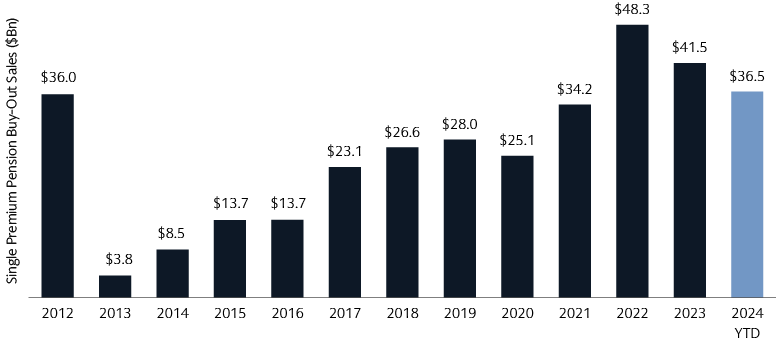
Source: LIMRA US Group Annuity Transfer Study and Goldman Sachs Asset Management. As of Q3 2024 (latest available). 2024 data is year-to-date through September 30, 2024.
Sponsors Evaluating More Durable Governance Models
The market for Outsourced Chief Investment Officer (OCIO) services continues to increase among many investor pools (see Exhibit 5). This is especially true in the corporate DB space where an increasing number of plan sponsors view their pension obligations as legacy liabilities where they would rather leverage an external partner than dedicate internal resources. Potential cost savings from an OCIO model as well as lack of succession planning options have likely also played a role in the decision-making process for plan sponsors.
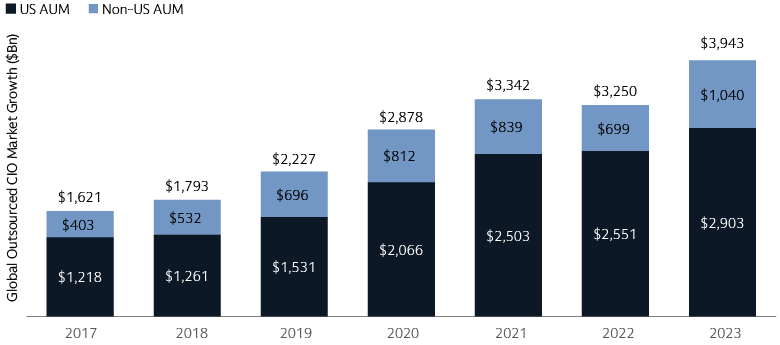
Source: Cerulli Associates: “U.S. Outsourced Chief Investment Officer Function 2024”, as of November 2024.
OCIO lift-out transactions involving UPS And Nokia in 2024 highlighted that this trend is moving up-market and can involve existing pension teams transferring to the OCIO provider. We might expect more large plans to explore this governance option in 2025.
Looking Forward: Potential Actions for Plan Sponsors to Consider in 2025
Hedge More Interest Rate and Credit Spread Risks – Add to High-Quality Long Credit
For plan sponsors with overfunded plans, particularly if they are closed or frozen, management of the plan may tilt more to reducing funded status volatility and protecting the current position of strength rather than taking significant asset risk. Since pension liabilities for both accounting and funding purposes are based on the yields of high-quality corporate bonds, these instruments can provide the best hedge.2
As such, many plan sponsors may wish to increase their allocations to long credit to hedge more of their interest rate and credit spread risks. Some plan sponsors, however, may be hesitant to add long credit when spreads are at historically low levels. Spreads are indeed tight, but history suggests they can remain tight for an extended period as long as certain macro, fundamental and technical conditions are met.
Our fixed income team believes macro conditions are in place for spreads to stay tighter for longer. Conservative capital deployment, healthy GDP growth, low unemployment and resilient consumer data all provide a supportive backdrop for credit. When combined with its position as a natural hedge to pension obligations, increasing the allocation to this asset class will likely make sense for many plan sponsors in 2025.
Diversify Growth Portfolio Away from US Large Cap – Add to US Small Cap and Non-US Equities
Large cap US growth has performed phenomenally well, and the Magnificent Seven now comprises about a third of the total market capitalization of the S&P 500. The equity market has been broadening out since before the US elections in early November, and we believe many factors are in place that will lead to that trend continuing in 2025.
In particular, the new US administration’s policies related to tariffs and taxes likely favor small cap stocks which have trailed their large cap brethren for an extended period and trade at a discount to historic valuations. This has also been an area that has provided ample alpha opportunities given, in some cases, lower sell side analyst coverage as well as a wider range of profitability.
Many international equity markets lagged the US once again in 2024, and tariff concerns will likely continue to weigh on them in 2025. Nonetheless, we see pockets of opportunity. European payout ratios are below historical levels, providing potential opportunities to rise in 2025. Our public markets CIO Ashish Shah believes 2025 will be a year for investors to diversify their portfolios with a focus on income, and equities with higher payout ratios could be a part of that equation.
In emerging markets, with much of the new administration’s focus on China, India may be a key beneficiary. Combined with structural advantages and sound demographics, we are optimistic on its prospects for 2025.
Evaluate Governance Models – Educate on OCIO and Lift-Outs
The OCIO model continues to gain traction, and high-profile lift-outs of pension teams have garnered the attention of C-Suite executives. Yet, many plan sponsors are still unfamiliar with the model, particularly those that involve moving an in-house pension team to an external OCIO provider.
For some sponsors, 2025 will provide a good opportunity to get up to speed on these governance models. This may be especially relevant for plan sponsors that don’t have a natural succession plan in place for a current CIO or pension manager and may be looking for a more sustainable governance model.
Examine All Use of Surplus Options – Consider Potential Benefits of Re-Opening a DB Plan
We estimate more than half of all US corporate DB plans today are in a surplus position. While those that are still open and accruing new benefits have a natural use for that surplus (i.e., to fund new benefit accruals), frozen plans may not.
While there are several economic uses of that surplus available for sponsors, one that is often overlooked is re-opening the DB plan and using the overfunding to pay for future benefit accruals. Oftentimes corporate managers may view re-opening a DB plan as a non-starter, but the financial benefits could be consequential when compared to providing employer contributions to a defined contribution program.
We explored this topic in last year’s review / preview piece and, while we found interest from plan sponsors to discuss the option, there was little receptivity to execute on the idea. Plan sponsors may wish to take a fresh look at the concept again in 2025.
1 De-risking strategies should not be construed as providing any assurance or guarantee that as a result of applying the strategy an investor will reduce and/or eliminate risk, as there are many factors that may impact end results such as interest rates, credit risk and other market risks. The portfolio risk management process includes an effort to monitor and manage risk, but does not imply low risk.
2 The economic and market forecasts presented herein are for informational purposes as of the date of this presentation. There can be no assurance that the forecasts will be achieved. Please see additional disclosures at the end of this presentation. The portfolio risk management process includes an effort to monitor and manage risk, but does not imply low risk. Diversification does not protect an investor from market risk and does not ensure a profit.
